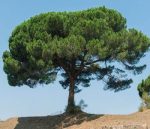 Also known as umbrella pine and parasol pine, this coniferous evergreen tree is native to the Mediterranean region including southern Europe, Israel, Lebanon and Syria. It is a member of the pine family, Pinaceae, that also includes spruce, hemlock, and larch. The trees may grow 30-80′ tall but usually no taller than 65′. They have a thick trunk with red-brown fissured bark and are branched to form a wide flat canopy at maturity. Small blue green juvenile needles are produced singly for the first 5-10 years and when the plant is injured, but are replaced gradually by stiff mid-green needles 4 to 8″ long and produced in bundles of two. Rounded-ovoid male and female cones are produced on the same tree and are shiny light brown, about 3-6″ long, and have blunt scales. Fertilized female cones produce edible nuts three years after being fertilized. Each nut is about 3/4″ long, pale brown with a black powdery coating that easily rubs off, and a ineffectual wing. Stone pine has been cultivated for over 6,000 years for its pine nuts but are also valued for their ornamental appeal, especially in parks and other public spaces. Small plants are used for table Christmas trees and bonsai. The genus name, Pinus, and specific epithet, pinea, both come from the Latin name for the tree.
Also known as umbrella pine and parasol pine, this coniferous evergreen tree is native to the Mediterranean region including southern Europe, Israel, Lebanon and Syria. It is a member of the pine family, Pinaceae, that also includes spruce, hemlock, and larch. The trees may grow 30-80′ tall but usually no taller than 65′. They have a thick trunk with red-brown fissured bark and are branched to form a wide flat canopy at maturity. Small blue green juvenile needles are produced singly for the first 5-10 years and when the plant is injured, but are replaced gradually by stiff mid-green needles 4 to 8″ long and produced in bundles of two. Rounded-ovoid male and female cones are produced on the same tree and are shiny light brown, about 3-6″ long, and have blunt scales. Fertilized female cones produce edible nuts three years after being fertilized. Each nut is about 3/4″ long, pale brown with a black powdery coating that easily rubs off, and a ineffectual wing. Stone pine has been cultivated for over 6,000 years for its pine nuts but are also valued for their ornamental appeal, especially in parks and other public spaces. Small plants are used for table Christmas trees and bonsai. The genus name, Pinus, and specific epithet, pinea, both come from the Latin name for the tree.
Type: Coniferous evergreen
Outstanding Feature: Form, edible nut
Form: Rounded, umbrella canopy
Growth Rate: Medium
Bloom: Not relevant
Size: 30-80′ H 26′ W
Light: Full sun
Soil: Average, dry to medium moist, well-drained
Hardiness: Zones 7-11
Care: No pruning necessary; low maintenance
Pests and Diseases: Honey fungus, adelgids, aphids, sawfly and pine shoot moth
Propagation: Seed
Photo Credit: Wikimedia Commons